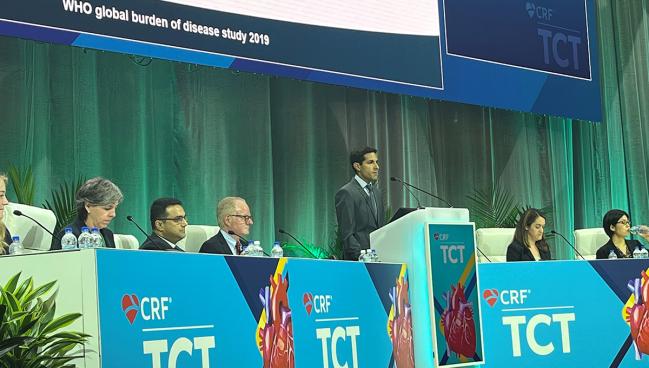Late Catch-up Sours SUGAR for Polymer-Free Stent in Diabetic Patients
The results didn’t meet superiority criteria, but researcher Pablo Salinas says he would be “happy with both stents.”

BOSTON, MA—With some late catch-up in events compared with what was observed at 1 year, the 2-year findings of the SUGAR trial do not show superiority of a polymer-free, amphilimus-eluting stent over a permanent-polymer zotarolimus-eluting stent (ZES) in diabetic patients with coronary artery disease.
As reported by TCTMD, the 1-year results of the investigator-initiated SUGAR trial of 1,175 patients showed a 35% risk reduction in the primary endpoint of target lesion failure (defined as a composite of cardiac death, target-vessel MI, and clinically indicated TLR) following PCI with the thin-strut, polymer-free Cre8 EVO stent (Alvimedica) compared with the Resolute Onyx ZES (Medtronic). That reduction met the constraints for noninferiority and—in a prespecified exploratory analysis—also demonstrated superiority.
That advantage, however, was lost by 2 years, Pablo Salinas, MD, PhD (Hospital Clínico San Carlos, Madrid, Spain), reported here at TCT 2022.
Investigators had originally hypothesized that the amphilimus formulation of the Cre8 EVO stent might be particularly beneficial in diabetic patients, who face increased risks of restenosis, because it might enable higher drug diffusion across the vessel wall. In the new data, however, “there isn't sufficient evidence” to show superiority of the Cre8 EVO stent in this setting, Salinas said.
Still, he told TCT attendees, “I think I would be happy with both stents” in this population, adding that they will be following the patients through 5 years.
During a press conference, Roxana Mehran, MD (Icahn School of Medicine at Mount Sinai, New York, NY), thanked the researchers for being “open and honest” and continuing their study. “We need to do something for diabetic patients with new stent technology, and I, too, was extremely excited about this particular stent,” she said. “You could have stopped at 1 year and been very, very happy with your positive result and walked away.”
Findings at 2 Years
Follow-up at 2 years remained excellent, with only eight and three patients lost to follow-up in the Cre8 EVO and Resolute Onyx groups, respectively.
There was no significant difference in the rate of TLF between the study and control arms (10.4% vs 12.1%; HR 0.84; 95% CI 0.60-1.19). Additionally, there were no differences for the individual endpoints of cardiac death (3.1% vs 3.4%; HR 0.81; 95% CI 0.42-1.55), target-vessel MI (6.6% vs 7.6%; HR 0.89; 95% 0.56-1.42), and TLR (4.3% vs 4.6%; HR 0.93; 95% CI 0.54-1.60). All secondary endpoints were comparable as well.
Salinas commented that both stents are “behaving well” at 2 years. “In terms of very technical stent design, the promise of the Cre8 Evo stent was fast elution at 90 days and then [it would] just leave a bare-metal stent behind. That means that you should have a very nice slow rate of events, but it is very steady. And the Resolute Onyx has a longer elution time, 180 days, [at which point] there seems to be a bump in restenosis, but then it is very nice to see that it is good. So this means that durable polymers are safe, because we are not seeing late events.”
Additionally, he specified that measuring events at 1 year is an “artificial” marker of time that is convenient for research but doesn’t mean much for patients. “There is no reason that the patient is really interested in having an event at 11 months versus 13 months,” Salinas said, adding that longer-term follow-up is still warranted.
Such Few Events
Also commenting to the media, Carlo Di Mario, MD, PhD (Careggi University Hospital, Florence, Italy), said, “It was a bitter note for the investigators to find this study that was positive at 1 year and now [no significant] P value at 2,” he said. “Having said that, maybe it is not bitter for us, because overall I think the percentages of the figures are so low that it is very difficult to find a difference.”
Still, observed press conference moderator Ori Ben-Yehuda, MD (Cardiovascular Research Foundation, New York), restenosis rates are “still much higher in diabetics, almost twofold higher,” as compared with patients without diabetes. “It's still a problem in this patient group,” he noted.
While the Cre8 EVO stent is not on the market yet in the United States, Salinas said it’s “very widespread” in Europe, where it received CE Mark status in 2017, as well as some countries in Latin America. For operators who currently have the choice of this device, he said, this study “reassures everyone that long-term events are low. There were only 25 events from 1 year to 2 years, and you really want to see a flat curve after that.”
Yael L. Maxwell is Senior Medical Journalist for TCTMD and Section Editor of TCTMD's Fellows Forum. She served as the inaugural…
Read Full BioSources
Salinas P. Two-year outcomes of the randomized second-generation drug-eluting stents in diabetes (SUGAR) trial. Presented at: TCT 2022. September 19, 2022. Boston, MA.
Disclosures
- Salinas reports receiving consulting fees/honoraria from Boston Scientific, Abbott Vascular, Biomenco, and Medtronic.





Comments